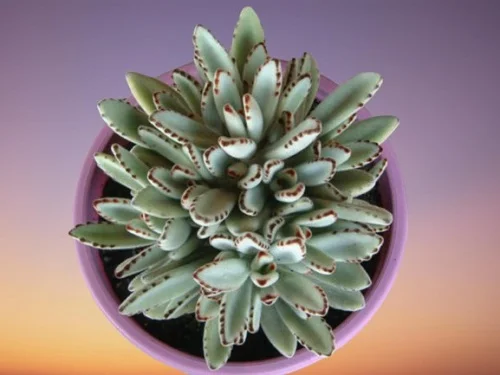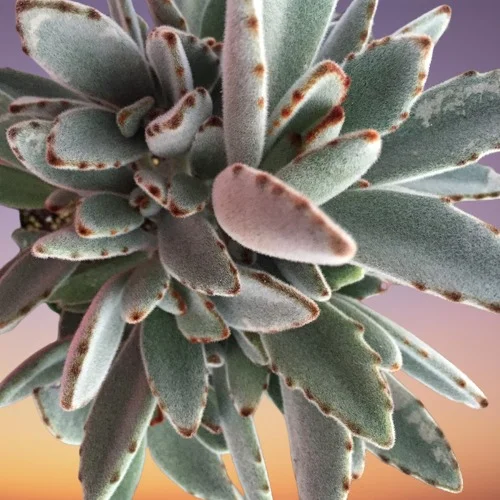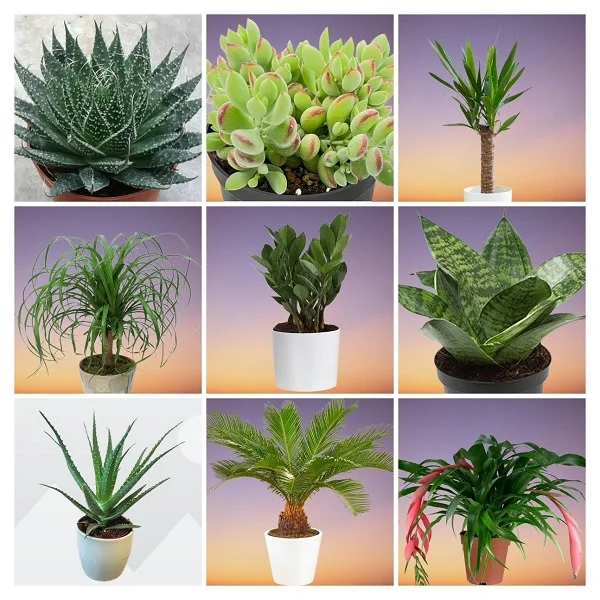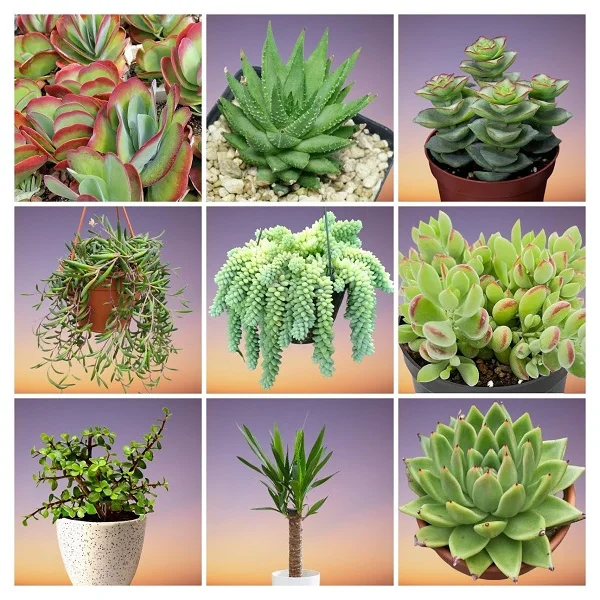How to Grow, Care and Propagate Panda Plant (Kalanchoe tomentosa)
Some links in this post may be affiliate links
Panda Plant (Kalanchoe tomentosa) prefers bright light to full sunlight, average warmth, moderate humidity and moderately moist, rich, well-drained, succulents soil coupled monthly feeding in the growing season.
Kalanchoe tomentosa also called Pussy Ears Kalanchoe or Chocolate Soldier is one of the magnificent Kalanchoe varieties with silvery-green, brown-edged, furry or woolly leaves and hence its other common names, 'Pussy Ears' and 'Chocolate Soldier'.
Pussy Ears Kalanchoe and its cousins Kalanchoe blossfeldiana (Flaming Katy), Kalanchoe daigremontiana (Devil's Backbone Kalanchoe) and Kalanchoe uniflora (Trailing Kalanchoe) are among the sun-loving plants as they require to be exposed to direct sunshine to thrive.

Botanical name: Kalanchoe tomentosa
Family: Crassulaceae
Common names: Panda Plant, Pussy Ears Kalanchoe, Chocolate Soldier
Origin
Kalanchoe tomentosa (Panda Plant) is native to Madagascar.
Size
Panda Plant is a small plant growing to a height of 1.5 feet only. On account of its compact size, Chocolate Soldier and its relatives Kalanchoe marmorata (Penwiper Plant) and Kalanchoe thyrsiflora (Paddle Plant) are some of the best plants for the limited spaces.
Flowers
When growing in its native habitat, it bears fuzzy, bell-shaped flowers but it rarely flowers when grown indoors.
Toxicity
According to ASPCA, Panda Plant (Kalanchoe tomentosa) like other Kalanchoe Plants contain Calcium glycosides which are toxic to animals. Keep the plant away from the reach of pets to avoid any mishaps.
Where to Buy
would you like to add Kalanchoe Plants to your collection? You may obtain them online from Etsy (Link to Etsy).
Kalanchoe tomentosa Care Indoors
Panda Plant (Kalanchoe tomentosa) thrives in bright light to full sunlight, average warmth of 16-260C, moderate humidity of 50-55% and moderately moist, rich, well-drained, succulents potting mix coupled monthly feeding during the growing season.
Kalanchoe tomentosa only requires repotting when it becomes pot-bound. Pruning is necessary to keep it neat and tidy. Keep reading for more on these growing conditions and how to provide them.

Light Requirements
Panda Plant grows best in bright light to full sunlight. Do not expose it to hot midday sunshine as it can scorch the leaves.
Kalanchoe tomentosa can be grown under grow lights if the natural light is insufficient. Take a look at these full spectrum grow lights on Amazon.
Regularly turn the pot to ensure that the plant gets adequate light on all sides for uniform growth and prevent legginess.
Should you choose to take your Pussy Ears Kalanchoe outdoors, gradually acclimate the plant and place it in a shaded place to avoid scorching the leaves.
Watering
Water Panda Plant liberally during the growing season and allow the top 2-3 inches of soil to dry out between waterings to keep the soil moderately moist.
Reduce watering significantly in the cold season as growth is reduced at this time to maintain the soil barely moist but do not allow it to dry out completely.
Ensure that the pot has a drainage hole to avoid getting soggy soil as it can lead to rotting and death of the plant.
Avoid wetting the leaves as it can lead to rotting. Water from the bottom instead. Use water that is at room temperature water to avoid shocking this tropical plant.
Temperature and Humidity
Average warmth temperatures of 16-260C are ideal for Panda Plant. The sudden change in temperature between day and night is excellent for this succulent plant. Keep it away from cold drafts to avoid flactuations in temperatures as they can result in reduced growth and death of the plant.
Panda Plant has no need for high humidity. Average room humidity of 50-55% is adequate for this plant. Ocassionally clean the leaves by damp-wiping with a soft cloth to get rid of dust and also discourage pest and disease infestations. Make sure that there is good air circulation to prevent fungal diseases.
Fertilizer
Feed Panda Plant monthly during the growing period with a balanced, liquid fertilizer but do not feed in the cold season as growth is minimal at this time and feeding at this time can lead to fertilizer burn.
Potting Soil
The best soil for Panda Plant should be rich in organic matter, loose and free-draining to avoid getting soggy soil. The soil should be loose enough to allow water to drain out fast enough. Cactus and succulents mix is ideal for this Kalanchoe.
Repotting
Repot Panda Plant only when the plant becomes pot-bound. Use a shallow rather than a deep pot as the plant has shallow roots. The pot should be only 1 size larger than the current one. Ensure the pot has a drainage hole to avoid getting soggy soil as it can lead to root-rot. A clay pot is preferable because it is porous and therefore allows the soil to dry out faster. Also ensure the soil is loose and free-draining. Check out these terracotta pots with saucer on Amazon.
Pruning
Pruning Panda Plant requires the removal of dead and diseased leaves to maintain the plant neat and tidy.
Propagation
Panda Plant (Kalanchoe tomentosa) can be propagated at the beginning of the growing season from leaf cuttings as they root easily.
How to propagate Panda Plant from Leaf Cuttings
Take leaf cuttings together with about an inch of the leaf petiole from a healthy Panda Plant.
Allow the leaf cuttings to dry (callus) for 1-3 days before planting to prevent rotting.
Insert the leaf petiole into moist, free-draining soil while ensuring that the midrib of the leaf also comes into contact with the soil.
Cover the set up with transparent polythene to raise humidity inorder to hasten rooting and establishment.
Position the set up in a warm, well-lit place. Water sparingly, only when the soil is dry.
Confirm that the rooting container has adequate drainage to avoid getting the soil soggy as it can lead to rotting of the leaf cuttings.
Once the plantlets have grown at least one set of leaves, carefully seperate them and pot in individual pots.
Place the new Pussy Ears Kalanchoe in a warm, well-lit spot and begin routine care.
Related: 5 Easy Ways to Propagate Kalanchoe (Kalanchoe Propagation)

Kalanchoe tomentosa Problems with Remedies
Panda Plant (Kalanchoe tomentosa) problems include dropping leaves, drooping leaves, leggy growth, rotting, shriveled leaves, pests and diseases among others. Keep reading for more on these problems, their remedies and solutions.
Pests
The common pests in Panda Plant are mealy bugs and scale insects. Isolate the affected plant to reduce spread to other plants and treat it with neem oil or insecticidal soap as per the manufaturer's recommendations.
Rotting base, yellowing and shriveled leaves
Panda Plant rotting base followed by yellowing and shriveled leaves is an indication of stem-rot disease which is enhanced by overwet conditions coupled with poor air circulation. Make sure that the pot has a drainage hole and that the soil is free-draining to prevent it from getting soggy. Improve ventilation and ensure that there is good air circulation for the plant.
Leggy growth
Panda Plant leggy growth is an indication that the lighting is inadequate. This is an attempt by the plant to reach for the light. Position the plant in a brighter spot where it will receive bright light to full sunlight or use a grow light where the lighting is not sufficient. Check out this guide on understanding light for houseplants.
Leaves falling off (dropping)
Falling or dropping leaves in Panda Plant is as a result of incorrect watering; either overwatering or underwatering. To avoid leaves falling off (dropping), water the plant thoroughly during the growing season and allow the top 2-3 inches of soil to dry out between waterings.
Significantly decrease watering during the cold season but never allow the soil ball to dry out completely. Avoid soggy soil by ensuring that the pot has a drainage hole and the soil is free-draining. Learn more on how to water indoor plants correctly.
Drooping leaves
Drooping leaves in Panda Plant are caused by underwatering. Immediately water the plant thoroughly and it should perk up. Thereafter, water the plant thoroughly during the growing season while allowing the top 2-3 inches of soil to dry out between waterings and maintain the soil moderately moist. During the cold season, water the plant less to keep the soil slightly moist but never allow the soil to dry out completely.
You liked it? Share on social media.
Related Content
Amazon Associates Disclosure
Homeplantsguide.com is a participant in the Amazon Services LLC Associates Program, an affiliate advertising program designed to provide a means for sites to earn advertising fees by advertising and linking to amazon.com.





